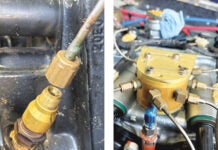Yes, know that I have written numerous times over the years about being careful about “while I’m in there…” syndrome—starting out on a simple project that turns out to be a complete restoration before you’re finished. However, sometimes, you get into a project, and it just doesn’t make sense NOT to fix things that come up along the way. For instance, when we found a crack in the motor mount of our 30-year-old RV-6, we had to pull the engine off to get the mount properly welded. In doing so, we discovered a few things that were not exactly up to standards anymore. First, because standards change as the world gets smarter, and second because things wear out. No blame here—the world is what the world is, and entropy is real.

So we had these two fuel lines—one from the gascolator to the pump, and the other from the pump to the carburetor. Both of them were quite oily from years of service, and when I pulled them out, it was obvious that the fire sleeves had never been finished properly—the ends were open, and the “fireproof” material was now soaked in flammable petroleum products. For the record, fire sleeve is supposed to be finished with specific clamps and end dip (usually, folks use red high-temp RTV) to actually do some good. After pulling off the contaminated sleeve, we found two different types of hose, so obviously, these had been replaced along the way, at separate times. With no pedigree, I was loathe to even test them and put them back in service, and fortunately, fire sleeve materials are expensive enough that it is cost-effective to just have new hoses (with integral fire sleeve) made up.
So I dropped a note to my long-time hose supplier, Tom Swearengen of TS Flightlines – now working as AS Flightlines Joint Venture. Tom has a process to produce pressure-tested hoses with integral fire sleeve – they are slimmer and more flexible, plus they are Teflon-lined, with a much longer life. I’ve used his services before to build custom hose assemblies for unique applications, and have always been happy. In this case, I simply told him I needed to -6 hoses for fuel with specific lengths, and a week later, a box showed up with the beauties you see in the picture.
Now I enjoy fabrication, and I even enjoy fabricating hoses – but a broken fuel line is a catastrophe forward of the firewall, so I am happy to have a person that build s them every day to them for me. And these thin flexible liens dress up any installation – so “while we’re in there…” it was the right thing to do!
Now how we got from an engine mount weld to a complete engine overhaul – well, I’ll leave that for a future installment of Kneeboard Notes.














can we note the different standard of pipes, hose, rubber parts replacement after 5 years?or one life reached to 5 years, it should be replaced?
Replacement intervals depend open the exact hose in use as well as the environment in which it is being used. In my investigations, hose manufacturers tend to leave it up to the airframe manufacturer to specify, and since homebuilders are their own airframe manufacturers, they have little to go by. I’d recommend consulting with your hose supplier to see what they say.
I need to replace all my hoses on a vansrv9a carburetor oil two to cooler one to pressure at firewall fuel from gascolator to pump pump to carburetor pump to pressure at fire wall